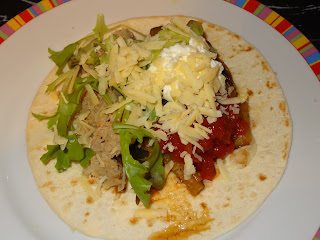A small thing made this dinner
blogworthy. I will come to that small thing later.
We'd enjoyed fish and chips with my
mother-in-law on Wednesday night and I was due out for a hen night
meal on Friday so Thursday needed to be a healthy day. The most
healthy thing would probably have been a salad, but I didn't fancy
that. What I fancied was something that would use up my bargain
aubergine that was looking like it wouldn't last much longer. And I
didn't fancy another moussaka. So what I decided on was roasted
vegetables with lentils. Augmented with some cheese, thus making a
highly healthy dinner slightly less healthy, but with the added bonus
of cheesy tastiness and calcium.
I selected the vegetables while heating
a little olive oil in a big dish in the oven. As well as the
aubergine, there was a golden courgette from our garden (it is
supposed to be golden) and I decided to use a red pepper too. I could
have added some carrot and potato but didn't want to break the theme
(which I suppose was loosely Mediterranean). In the time it took to
chop all the vegetables the oven had reached temperature (hottish)
and so the roasting process started.
Many of my friends frown at me when I
extol the tastiness of lentils, but they really can be delicious.
Tonight I would be doing some simple braised lentils. I started off
by gently “sweating” (sorry, horrible word) an onion, a couple of
sticks of celery and a couple of carrots (all chopped fairly small).
I didn't measure the lentils, probably about 100g (but I'm not good
at estimating weight), enough to come up about half way in a normal
size sieve. The lentils go in the sieve to be rinsed thoroughly. I
once had a bit of grit in my lentils so at least by rinsing them the
risk is reduced to clean grit. The lentils then go in the pan with
the onion, celery and carrot and I added enough water (from a boiled
kettle) to just cover everything. As is my preference I added some
yeast extract (from a squeezy pot that Matt bought – here is not
the right forum to go into the pros and cons of yeast extract in
squeezy pots versus the traditional jar) and a spoonful of vegetable
stock powder. Then all I did was to leave it to simmer on the hob and
hope that it would be ready at the same time as the roasted
vegetables.
The vegetables looked to be coming on
nicely, but needed some seasoning. (Watch out, the small thing is
coming up soon.) I added salt and pepper and sent Matt out to the
garden to choose some herbs. He chose some oregano (at least I think
it is oregano, it might be marjoram, but oregano and marjoram might
actually be the same thing). Matt duly washed the herb (we have some
unreliable neighbourhood cats) and threw it in on top of the
vegetables in the oven.
This was all going on in the background
while I topped and tailed some green beans that my mum had sent us
home with from her garden. I was disturbed from my top and tailing
reverie by a cry of “Quick get some tongs!”. It transpired that
Matt's herb washing had failed to dislodge (or even identify the
presence of) a caterpillar. Being the animal lover that he is Matt
was frantic to save said creature. I extracted the dish from the
oven, Matt found the tongs and extracted the caterpillar from the
dish. Being the animal lover that he is that was not sufficient for
Matt so while I returned to my beans he took the caterpillar to the
park.
I wanted tomato to feature somewhere in
this dinner – it would probably be ok added to either the lentils
or the oven vegetables. If I only had tinned tomatoes it would have
been a no brainer to add these to the lentil pan, but I had some
lovely cherry tomatoes and decided that I'd put a few of these (minus
caterpillars) in the oven. So it would be a kind of oven roasted
ratatouille.
Everything was sort of looking ready so
I took a chance and put the green beans in to cook. I also added a
splash of balsamic vinegar to the lentils, it adds just a little
sharpness otherwise they can be very rich. All that was left for me
to do was to chop the feta (almost any strong / salty cheese would
probably be fine but we had two blocks of feta for some reason) and
beckon Matt to serve it all up (I am useless at serving food).






















